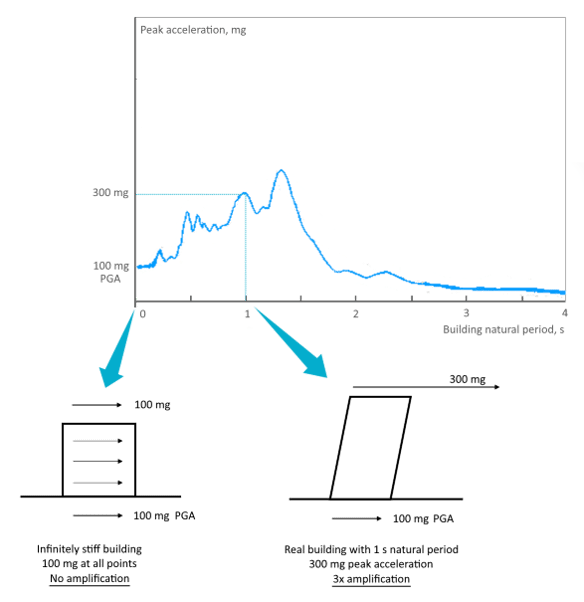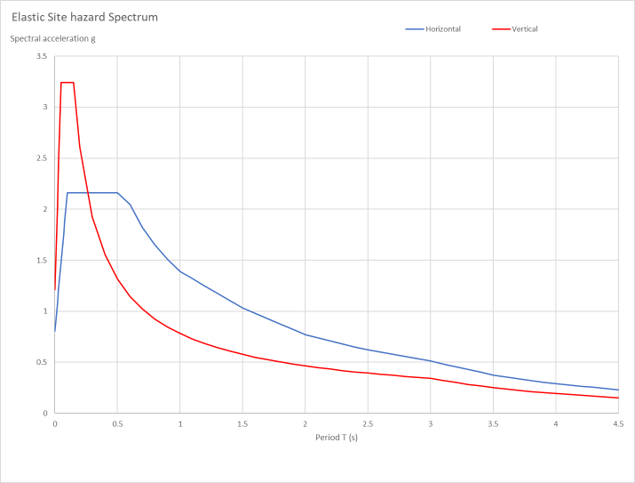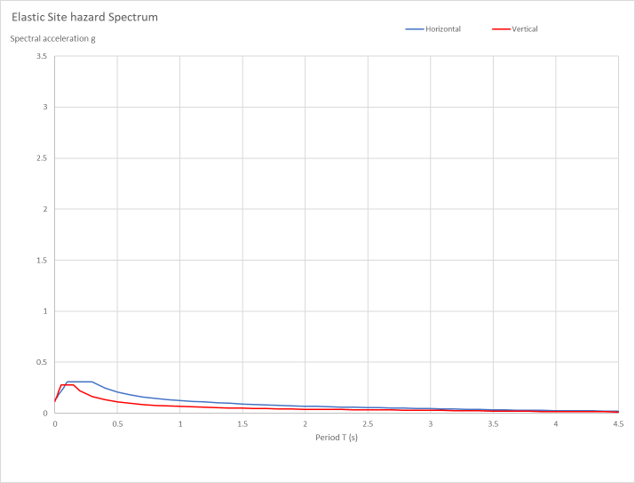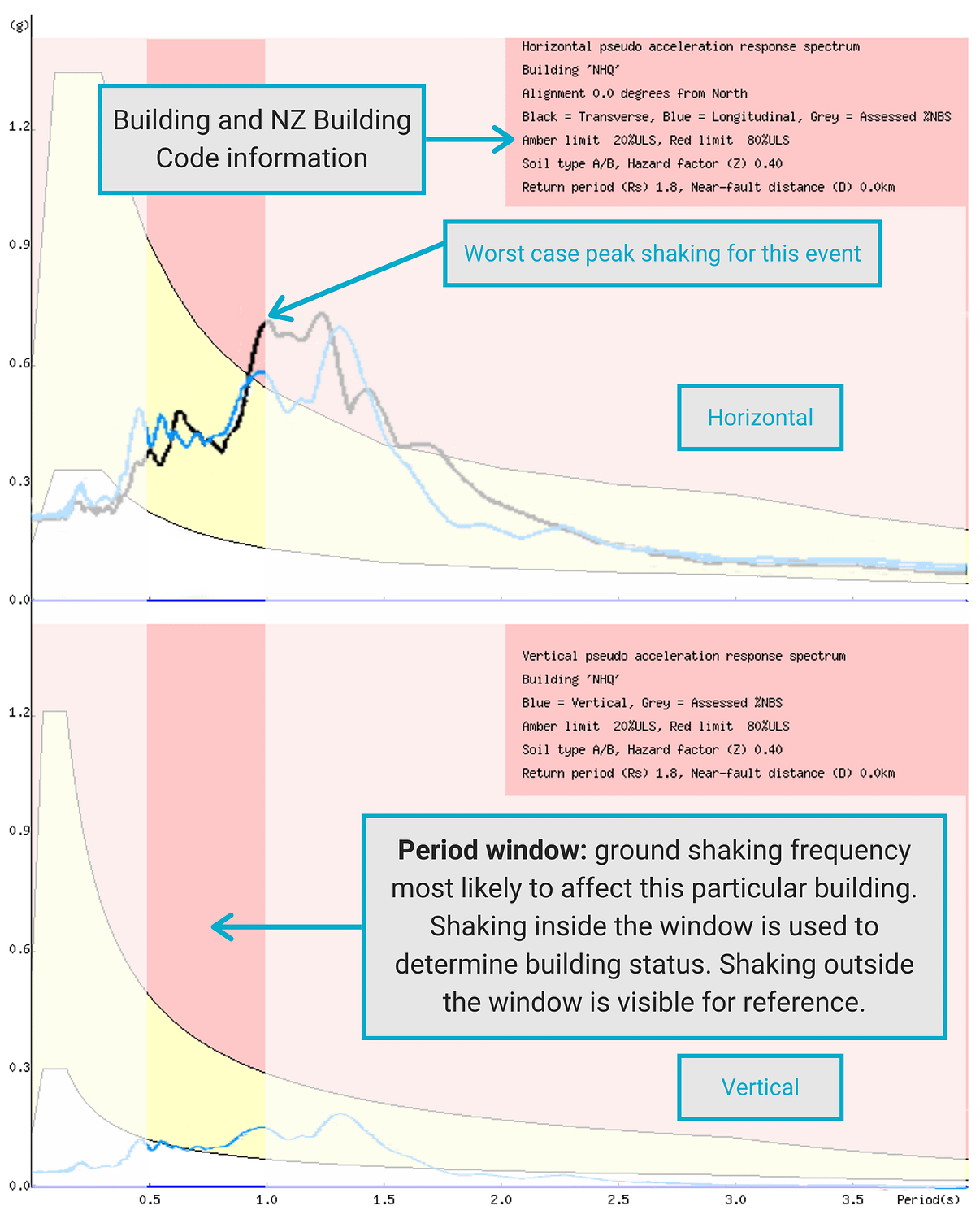How Sentinel works
Sentinel is an earthquake response and resilience tool that provides instant alerts on the status of your building after an earthquake.
Overview how Sentinel works
Sentinel earthquake measurements: the basics
Every Sentinel sensor delivers raw data in the form of a time-series record of acceleration vs time (200 samples per second)

Why acceleration?
Acceleration is proportional to load (F=ma)
Peak ground acceleration (PGA) is sometimes used as a proxy for the maximum force imparted on a structure during a quake.
Remember – shaking is three dimensional. Reported PGA is the maximum vector sum in 3D.
5 mg ~ the minimum shaking felt by a person
20 mg ~ the minimum that might have some effect on a structure
What is Sentinel spectral ground response?
A building is like a tuning fork or child’s swing – it has a natural frequency (or period) at which it will vibrate. If earthquake shaking “excites” the building at its natural period, the effect on the building will be more severe than a simple PGA measurement would suggest. The ground shaking is amplified by the building’s response. The ground response spectra is generated by mathematically applying the ground shaking acceleration record to calculate the response of a series of “tuning forks” (each being a simple building vibration model) across a range of different periods. Across a period range of 0-4 seconds, Sentinel does this 800 times, each tuning fork covering a period of 0.005 seconds. We can then see which tuning fork (which buildings) respond most strongly to the ground shaking of a particular earthquake.
Why is Sentinel spectral ground response useful?

The response of any particular building (using its measured, calculated or estimated natural period) can be taken directly from the ground response spectrum at that period. This is important because it means we know how the building’s structure has amplified the ground shaking.
This is a much better damage indicator than using ground shaking PGA – it tells us the amplified acceleration (and hence forces) experienced by the structure
Why is Sentinel spectral ground response useful?
The New Zealand Building Code building strength requirements are defined in terms of ground response spectra. This means we can compare the earthquake ground shaking directly to the design of the building.
The NZ Building Code defines “limit state curves”. These curves are the ground response spectra envelope within which all earthquakes expected in the building’s design life will occur. The design engineer must ensure the
building’s performance is greater than the required curve.
Ultimate Limit State (ULS): if the shaking is greater than this curve, structural damage might be expected
Service Limit State (SLS): if the shaking is greater than this curve, nonstructural damage might be expected (lights, ceiling tiles, windows, pipes, etc)
The limit curves are adjusted based on:
Hazard: a location factor based on the estimated risk of damaging ground shaking. Wellington 0.4, Christchurch 0.3, Auckland 0.13
Soil class: a site-specific factor derived from the ground conditions. A/B = stiff, D = soft, E = very soft
Return period: a factor based on the annual probability of an earthquake exceeding the design intent. This is usually based on the IL (Importance Level) of the structure. IL2 = most commercial buildings, IL4 = critical facilities like hospitals
Near fault factor: applied to those locations close to major faults (<20 km).
Vertical and horizontal limit curves are derived separately
For older buildings, the %NBS rating can be used to scale the limit curves downward.




What do I see from Sentinel?


Sentinel spectral response
Peak shaking is determined in the Period Window: Status determined on the worst case of three axis (two horizontal, one vertical). Limits can be configured to suit you. Typical settings as follows:
Peak shaking inside white limit: typically set as SLS. Take no action
Peak shaking inside amber limit: typically set at ULS. Activate ERP, shaking may have caused non-structural damage
Peak shaking above amber limit (red): above ULS. Activate ERP, shaking may have caused structural damage